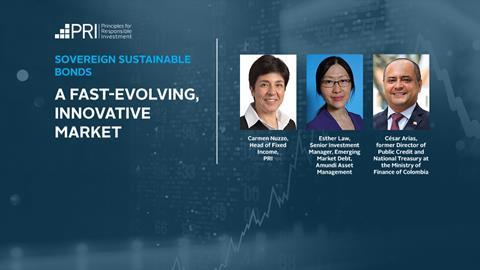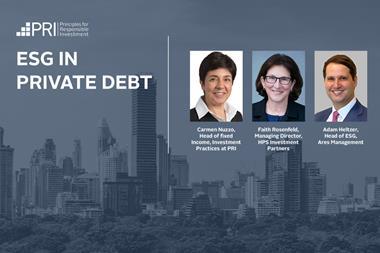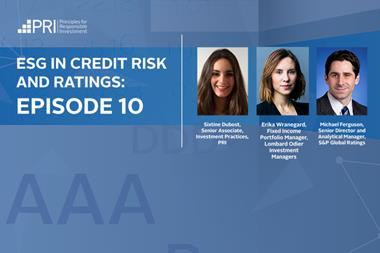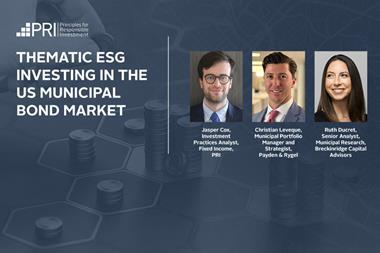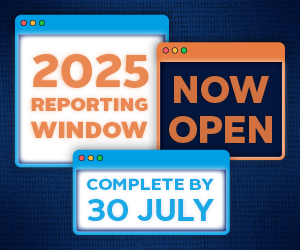Many governments are turning to labelled sustainable bonds, and Latin American sovereigns have been particularly innovative.
The PRI’s latest podcast delves into the issuer and investor perspective, and the different types of bonds coming to the market.
In this podcast we discuss:
- The state and evolution of the sovereign sustainable bond market
- How Latin America have approached this market and how Columbia, Mexico, and Chile have been the leaders in this space.
- Weighing up use-of-proceeds labelled bonds versus sustainability-linked bonds
It features Esther Law, who is a Senior Investment Manager in Emerging Market Debt at Amundi and César Arias, the former Director of Public Credit and National Treasury at the Ministry of Finance of Colombia.
Find transcript here
With Carmen Nuzzo, Head of Fixed Income, PRI, Esther Law, who is a Senior Investment Manager in Emerging Market Debt at Amundi and César Arias, the former Director of Public Credit and National Treasury at the Ministry of Finance of Colombia.With Carmen Nuzzo, Head of Fixed Income, PRI, Esther Law, Senior Investment Manager, Emerging Market Debt, Amundi, César Arias, former Director of Public Credit and National Treasury at the Ministry of Finance of Colombia
Note: The Principles for Responsible Investment podcast is designed to be heard. If you are unable to do this, this transcript offers an insight into the episode.
Transcripts are generated using a combination of speech recognition software and human transcribers, and may contain the occasional error. Please check the corresponding audio before quoting in print.
Subscribe to the channel via Apple podcasts, Spotify, or wherever you listen to your podcasts.
Carmen Nuzzo
Welcome to this new podcast by the PRI, which will explore the rapid growth and the evolution of the sovereign sustainable bond market. My name is Carmen Nuzzo. I’m the head of the fixed income program at the PRI, and I’m joined today to discuss this topic by Esther Law, Senior Investment Manager, emerging market debt specializing on sovereign bonds, who has been very active in the ESG thematic investing area. And César Arias, former director of Public Credit and National Treasury at the Ministry of Finance of Columbia, and has a well-rounded market experience that he has acquired in banking on the credit leading agency side and working for supernational organizations like the International Monetary Fund. Welcome to you both.
Esther Law
Thank you Carmen. It’s nice to be with you and César today.
César Arias
It’s a pleasure to be here.
Carmen Nuzzo
Welcome to this new podcast by the PRI, which will explore the rapid growth and the evolution of the sovereign sustainable bond market. My name is Carmen Nuzzo. I’m the head of the fixed income program at the PRI, and I’m joined today to discuss this topic by Esther Law, Senior Investment Manager, emerging market debt specializing on sovereign bonds, who has been very active in the ESG thematic investing area. And César Arias, former director of Public Credit and National Treasury at the Ministry of Finance of Columbia, and has a well-rounded market experience that he has acquired in banking on the credit leading agency side and working for supernational organizations like the International Monetary Fund. Welcome to you both.
Esther Law
Thank you Carmen. It’s nice to be with you and César today.
César Arias
It’s a pleasure to be here.
Carmen Nuzzo
Let me start by saying sovereign issuers have come later than corporates to the sustainable bond market, but have contributed notably to its growth in the last few years. To be clear, what I mean with the term sustainable bonds is bonds that come to the market with a label comprising a variety of instruments such as green social sustainability bonds, now also known as GSS bonds, as well as more recently, sustainability linked bonds or SLBs. The bank for international settlements estimated that this GSS alone reached nearly 3 trillion by mid-2022. Sovereign increasing their share of the total outstanding volume from four to 7.5% in just two and a half years. Even if the market’s segment is still relatively small, it’s growth has being phenomenal. Esther, let me turn to you for my first question before we start talking about the evolution of this market and it’s rapid growth. Can we get the basics right and can you explain what are the different structures that underpin these instruments?
Ester Law
There are two types of sustainable bonds. So, the first one is the use of proceeds, the main part of the sustainable bond market, and the second type is the more newcomer. That’s the sustainability linked bonds. The second one being a bit new to the market right now, the way how it’s defined, how this regulated is still a bit unclear compared with the use of proceeds green bonds, which you know, we have the green bond principles data back as far back as 2009.
Carmen Nuzzo
César, let me turn to you because Latin America has been a particularly innovative region of the world when it comes to sustainable bond markets. Can you tell us about the evolution that you’ve seen from your side?
César Arias
I would like to highlight in general three trends. The first one is that growth was exponential. During the pandemic, as you said, global issuance increased sevenfold consolidating a market of $3.3 trillion by last year. However, ESG debt suffered its first decline in a decade last year due to the environment of rising interest rates on heightened volatility. And this risk aversion affected disproportionally emerging markets. While ESG issuance contracted 20% globally, it contracted 32% in emerging markets. The second trend is that EM sovereigns made their bond frameworks more flexible to overcome limitations in the volume of eligible budget projects and market liquidity. First, they complemented the traditional use of produce approach with the possibility to issue sustainability linked bonds, but they also complimented their green bonds frameworks with more social and sustainability considerations.
César Arias
The prime example for this is Chile. It has issued $33 billion in label bonds since 2019, which is nearly 30% of its total outstanding debt from this 54% is social, 23% is green, 17% is sustainable, and 6% is sustainability link. And the last trend that I would like to highlight is that EM sovereigns’ beer to the local currency in an effort to mitigate foreign exchange risk and further develop their local capital markets. Around a third of ESG bond supply payments by emerging markets in the last three years is in local currency. Latin America, Columbia, Mexico, and Chile have been the leaders in this space attracting important participation from foreign investors. And in Asia, Thailand, Malaysia and Indonesia are the leaders leveraging on the depth of their domestic capital markets.
Carmen Nuzzo
You alluded already to the advantages that sovereigns may have initiating these types of bonds. That is diversification of the investor base but are there other financial benefits in these labelled sustainable bonds that make them attractive for countries issuers.
César Arias
Sovereigns have used three innovating pricing mechanisms to respond to that question, Carmen, and the answer is that they have gotten positive results. Colombia, when I was at the debt management office, issued local currency bonds with a twin bond structure that allows to track the difference in pricing between a convention and a green bond. And we found a greenium in the secondary market of 10 basis points. These 10 basis points are comparable to the greening that you see with the German twin bonds and interestingly launched last year also. The second innovation is that when Chile launched its first sustainability link bunk, incorporated in a step-up coupon, 12.5 basis points to 25 basic points penalty if their performance indicators were not met in greenhouse emissions and the transition to renewable non-conventional energy. While this bond was oversubscribed and the sovereign in place, $2 billion at 20 years at a rate of 4.3%. And the final innovation was Uruguay, which added a step-down coupon in a sustainability linked bond last October of between 15 to 30 basis points. In case of overperforming, their performer targets related to reductions in greenhouse emissions and conservation of natural forest. The market response was satisfactory. The transaction was covered 2.6 times and the sovereign place $1.5 billion for financing and liability management at 15 years and a yield of 5.9%.
Carmen Nuzzo
César, just let me explain some of the terminology that you’ve used. Greenium is effectively a lower yield, a lower cost of borrowing for the issuers compared to a bond with a similar maturity but not carrying a label. And the step-down coupon is basically an adjustment that is made either way to do coupon step up, meaning that the issuer would pay more to the investor in case it doesn’t meet certain performance targets and vice versa with the step down, it would pay less if he met such targets or even exceeds them. Just one last question because I want to turn to Esther. You mentioned Chile, Colombia and Uruguay, but have there been any other innovative forms of funding, not necessarily through bonds that are related to environmental issues in recent years?
César Arias
The short answer is yes. Innovation in Greece finance is also yielding benefits for lower rated sovereigns in emerging markets. Costa Rica will be the first sovereign in the world to access the International Monetary Funds sustainability and resilience fund. This is a new facility that promotes climate change reforms through long-term and affordable resources to low- and middle-income countries. There is a pool there of $40 billion in Loanable resources that are accessible by 75% of the IMF members and it’s a facility that lends at 20 years with a 10-year grace period. In fact, also the country of Barbados and Rwanda are next in the pipeline to access this line. And the second innovation is blended finance, this mix of private capital with credit enhancements from multilaterals and concessional funds. The two prime examples of these type of transactions are the debt conversions that are country like Barbados conducted through blue bonds and loans for hundred and $46 million, which generated $50 million in savings for marine conservation. A similar exercise but twice the size. 364 millions was conducted by Belize a year ago, in which the National Conservancy sponsored the transaction and the US International Development Corporation provided political insurance allowing sizable reductions in the debt burden, inter savings and resources that can be channelled for ocean conservation.
Carmen Nuzzo
It’d be interesting to see if Costa Rica, if and how Costa Rica will access this new sustainability and resilience fund by the International Monetary Fund. Esther, let me turn to you because I’m really interested in what you think of these instruments, how you use them and actually what your concerns are around them, if any.
Ester Law
No, it’s very interesting that César was using the example of Uruguay, which I know, personally engaged with during the design process. The use of proceeds are by far the easiest because as my opening comment it is more well defined, right? It’s more well-structured. Climate bond initiative was created in COP 15 back in 2009 by John McKinney who has been helping out in shaping, you know, green bond framework in many, many countries. Whereas the sustainability linked bonds have only, you know, become inter profession in really like maybe one year to 18 months. So, for me, even though SLBs are covering a broader area, it could include also education, diversity, et cetera. I feel that the monitoring side is still, lagging and the standardization is not there. I think the industry is well aware of that and to mitigate that, a few, you know, a few of the asset owners together with PRI and also asset managers have formed this group called the ASCO Group and that stands for assessing sovereign climate related opportunities and risks to help set up a framework on sovereigns to measure climate risks and opportunities.
Esther Law
For me, it is very encouraging that yes, we should be having a critical mind in what is not perfect. That is a lot of effort being put in to make it better.
Carmen Nuzzo
I’m glad Esther, that you mentioned us for the assessing sovereign climate related opportunities and risks that will be launched quite soon. In fact, we’re embarking in a large public consultation in the next few months because this is something that could really facilitate the analysis by investors, but also ease the reporting burden by sovereigns. In fact, one question I had for César is, what do that management offices need to consider when structure these bonds? Because many have been reluctant to issue such bonds since they’re a bit onerous in terms of structuring, but also on the reporting side.
César Arias
In my experience in the debt management Office of Columbia, one key factor is institutionality. Label bonds have to survive the tax of elections of changes in government and environmental and social policies. This is critical for continuity, for credibility, market liquidity, and ultimately for pricing. Debt managers across mature and emerging markets are creating dedicated sustainable finance units with legal capacity, competent staffed and coordinating mechanisms with other line ministers and debt managers are constantly being trained by these other line ministries. When we have to go on a road show on a placing mechanism and the interaction with investors. Data quality and transparency is also important. The hard part of label bonds starts the day after the issuance. You have to design performance indicators, monitor them and be accountable to investors. Budget tagging and reporting are increasingly standardized, but impact reporting is still an area of development through auditing and consistent with national and international taxonomies. And finally, as, I like to say in the debt office, communication, communication and communication. This is important inside the government with congress, with public opinion and of course with domestic and international investors.
Carmen Nuzzo
I like that you said communication, communication, communication. Because engagement is really one of the themes that at the PRI we have been pursuing in the last few years really trying to educate our signatory base to the fact that sovereign engagement is possible. In fact, it’s been happening for many years, but not to the extent that we would like to see on around ESG issues in particular or sustainability issues. To which extent, Esther, do you think that these bonds, these sustainable bonds can facilitate engagement with sovereign issuers?
Ester Law
I actually have very interesting experience with different types and styles of government in terms of facilitating, green finance and engagement. I think it makes a difference. Of course, it, again, it varies from the impact and the shape and form. But what I have clearly observed is you have obviously, advanced one ie, they as a nation, they already very aware of this. You know, at this move they believe in, green finance, they believe this is necessary to happen. For that the conversation would be much easier. There are also for sovereigns who are maybe less buy into the idea or treating it as a bit of a less of a priority. I observe that if we engage as a group, so me with my other peers and together with yourself, PRI, we have been able to make an impact already and we are seeing those issuers who were much less interested in this topic to start picking up, to start talking to us like, you know, Esther, can I have a call? Can I understand for Amundi, what is the minimum requirement you need for green bond? For example. There are loads of criticisms, huge room for improvement, but it is moving in the right direction.
Carmen Nuzzo
César, based on your experience as a director of the that management Office of Columbia, is it better to engage in a one-to-one basis or do you like actually this idea of more collaborative action by investors?
César Arias
I think they are not mutually exclusive label bonds definitely facilitate engagement investors due diligence on conventional sovereign bonds is become permanent and very standardized. Technically speaking, you can issue at any moment even without a RO show, particularly after the pandemic. However, the scrutiny on label bonds is deeper and very differentiated by type of instrument. And these forces that or promotes that ESG investors engage in a permanent dialogue with DMOS in two dimensions. One is the financial allocation report or the financial aspect of it, which is also turning more standardized and it has for example, a mandatory audit by external party, which is positive, but again, impact reports are more complex heterogeneous and they don’t require yet a mandatory auditing or verification system. So here is where taxonomies can play a very important role. As I was saying, Columbia was the first country to adopt taxonomy in the Americas, but now countries as different as Dominican Republic, Canada, Mexico, and Chile are working on defining and adopting these taxonomies.
Carmen Nuzzo
I’m afraid César, I have to stop here. Definitely, this is a subject that we will have to revisit because what you mentioned about the proliferation of the taxonomies is an issue. Thank you so much Esther and César for sharing with us your experience. You can find more resources on sovereign debt at www.unpri.org/sovereign debt on the PRI website, including on ASCOR, the assessing Sovereign Climate related Opportunity and Risks framework. There will be a public consultation this year. On the website, you will find ways in which you can get involved and also take a look at the generic fixed income page, www.unpr.org/fi, where you will find a wealth of resources related to fixed income more broadly. Thanks for listening. Goodbye for now.
Downloads
Sovereign sustainable bonds: transcript
PDF, Size 0.21 mb


